Although Linux has made some inroads into the desktop market, its origins and future are very much server based. It is unsurprising, therefore, that Ubuntu can act as a file server. It is also common for Ubuntu and Windows systems to be used side by side in networked environments. Therefore, it is a common requirement that files on an Ubuntu system be accessible to Linux, UNIX, and Windows-based systems over network connections. Similarly, shared folders and printers residing on Windows systems may also need to be accessible from Ubuntu-based systems. Windows systems share resources such as file systems and printers using the Server Message Block (SMB) protocol. For an Ubuntu system to serve such resources over a network to a Windows system and vice versa, it must support SMB. This is achieved using a technology called Samba. In addition to providing integration between Linux and Windows systems, Samba may also provide folder sharing between Linux systems (as an alternative to NFS covered in the previous chapter).
In this chapter, we will look at the steps necessary to share file system resources and printers on an Ubuntu system with remote Windows and Linux systems and to access Windows resources from Ubuntu.
Accessing Windows Resources from the GNOME Desktop
Before getting into more details of Samba sharing, it is worth noting that if all you want to do is access Windows shared folders from within the GNOME desktop, then support is already provided within the GNOME Files application. The Files application is located in the dash as highlighted in Figure 21-1:

Once launched, select the Other Locations option in the left-hand navigation panel, followed by the Windows Network icon in the main panel to browse available Windows resources:
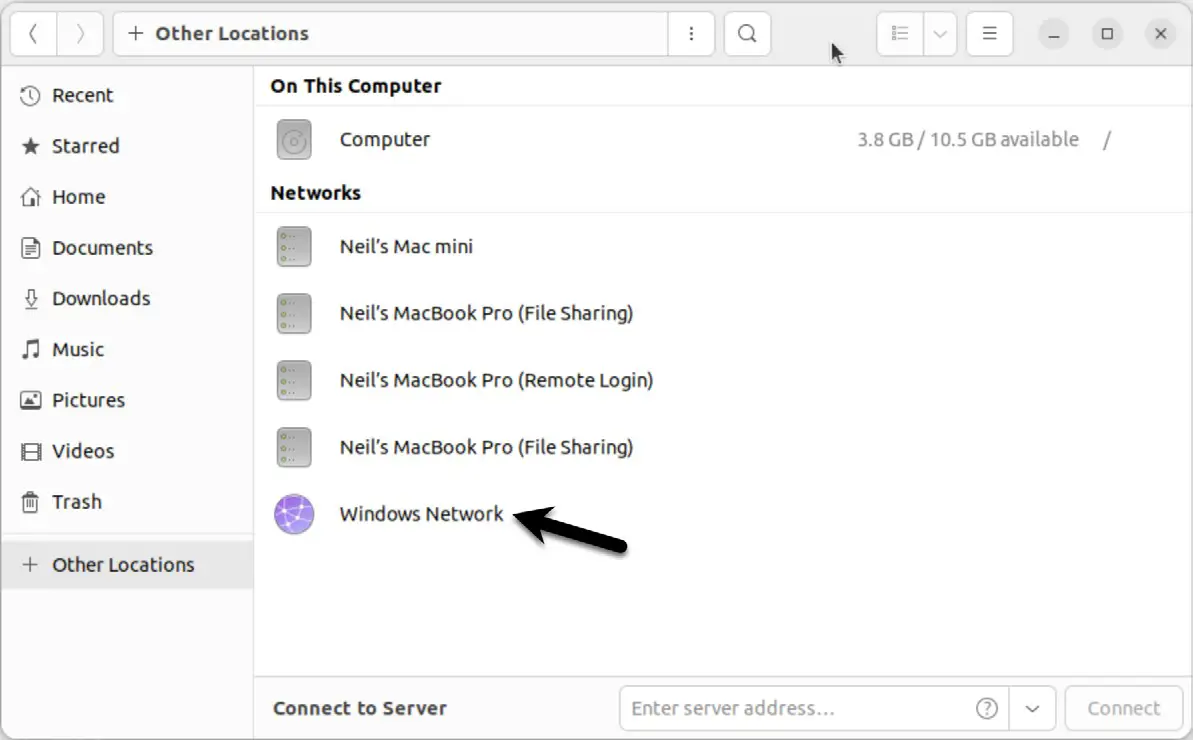
Samba and Samba Client
Samba allows both Ubuntu resources to be shared with Windows systems and Windows resources to be shared with Ubuntu systems. Ubuntu accesses Windows resources using the Samba client. On the other hand, Ubuntu resources are shared with Windows systems by installing and configuring the Samba service.
 |
You are reading a sample chapter from Ubuntu 22.04 Essentials. Buy the full book now in eBook ($24.99) format. Includes 36 chapters. Learn more. |
Installing Samba on Ubuntu
The default settings used during the Ubuntu installation do not typically install the necessary Samba packages. Unless you specifically requested that Samba be installed, it is unlikely that you have Samba installed on your system. To check whether Samba is installed, open a terminal window and run the following command and check for the [installed] indicator for each package:
# apt -qq list samba-common samba smbclientCode language: plaintext (plaintext)Any missing packages can be installed using the apt command-line tool:
# apt install samba-common samba smbclientCode language: plaintext (plaintext)Configuring the Ubuntu Firewall to Enable Samba
Next, the firewall protecting the Ubuntu system must be configured to allow Samba traffic. If you are using the Uncomplicated Firewall (ufw) run the following command:
# ufw allow sambaCode language: plaintext (plaintext)Alternatively, if you are using firewalld, run the firewall-cmd command as follows:
# firewall-cmd --permanent --add-port={139/tcp,445/tcp}
# firewall-cmd --reloadCode language: plaintext (plaintext)Before starting the Samba service, some configuration steps are necessary to define how the Ubuntu system will appear to Windows systems and the resources to be shared with remote clients. Most configuration tasks occur within the /etc/samba/smb.conf file.
 |
You are reading a sample chapter from Ubuntu 22.04 Essentials. Buy the full book now in eBook ($24.99) format. Includes 36 chapters. Learn more. |
Configuring the smb.conf File
Samba is a highly flexible and configurable system that provides many options for controlling how resources are shared on Windows networks. Unfortunately, this flexibility can lead to the sense that Samba is overly complex. In reality, however, the typical installation does not need many configuration options, and the learning curve to set up a basic configuration is relatively short.
For this chapter, we will look at joining an Ubuntu system to a Windows workgroup and setting up a directory as a shared resource that a specific user can access. This is a configuration known as a standalone Samba server. More advanced configurations, such as integrating Samba within an Active Directory environment, are also available, though these are outside the scope of this book.
The first step in configuring Samba is to edit the /etc/samba/smb.conf file.
Configuring the [global] Section
The smb.conf file is divided into sections. The first section is the [global] section, where settings that apply to the entire Samba configuration can be specified. While these settings are global, each option may be overridden within other configuration file sections.
The first task is defining the Windows workgroup name on which the Ubuntu resources will be shared. This is controlled via the workgroup = directive of the [global] section, which by default is configured as follows:
 |
You are reading a sample chapter from Ubuntu 22.04 Essentials. Buy the full book now in eBook ($24.99) format. Includes 36 chapters. Learn more. |
workgroup = WORKGROUPCode language: plaintext (plaintext)Begin by changing this to the actual name of the workgroup if necessary.
In addition to the workgroup setting, the other settings indicate that this is a standalone server on which user passwords will protect the shared resources. Before moving on to configuring the resources to be shared, other parameters also need to be added to the [global] section as follows:
[global]
.
.
netbios name = LinuxServerCode language: plaintext (plaintext)The “netbios name” property specifies the name by which the server will be visible to other systems on the network.
Configuring a Shared Resource
The next step is configuring the shared resources (in other words, the resources that will be accessible from other systems on the Windows network). To achieve this, the section is given a name by which it will be referred when shared. For example, if we plan to share the /sampleshare directory of our Ubuntu system, we might entitle the section [sampleshare]. In this section, a variety of configuration options are possible. For this example, however, we will define the directory that is to be shared, indicate that the directory is both browsable and writable, and declare the resource public so that guest users can gain access:
[sampleshare]
comment = Example Samba share
path = /sampleshare
browseable = Yes
public = yes
writable = yesCode language: plaintext (plaintext)To restrict access to specific users, the “valid users” property may be used, for example:
 |
You are reading a sample chapter from Ubuntu 22.04 Essentials. Buy the full book now in eBook ($24.99) format. Includes 36 chapters. Learn more. |
valid users = demo, bobyoung, marcewingCode language: plaintext (plaintext)Removing Unnecessary Shares
The smb.conf file is pre-configured with sections for sharing printers and the home folders of the users on the system. If these resources do not need to be shared, the corresponding sections can be commented out so that Samba ignores them. In the following example, the [homes] section has been commented out:
.
.
#[homes]
# comment = Home Directories
# valid users = %S, %D%w%S
# browseable = No
# read only = No
# inherit acls = Yes
.
.Code language: plaintext (plaintext)Creating a Samba User
Any user that requires access to a Samba shared resource must be configured as a Samba User and assigned a password. This task is achieved using the smbpasswd command-line tool. Consider, for example, that a user named demo is required to be able to access the /sampleshare directory of our Ubuntu system from a Windows system. To fulfill this requirement, we must add demo as a Samba user as follows:
# smbpasswd -a demo
New SMB password:
Retype new SMB password:
Added user demo.Code language: plaintext (plaintext)Now that we have completed the configuration of an elementary Samba server, it is time to test our configuration file and then start the Samba services.
Testing the smb.conf File
The settings in the smb.conf file may be checked for errors using the testparm command-line tool as follows:
# testparm
Load smb config files from /etc/samba/smb.conf
Loaded services file OK.
Weak crypto is allowed
Server role: ROLE_STANDALONE
Press enter to see a dump of your service definitions
# Global parameters
[global]
log file = /var/log/samba/%m.log
netbios name = LINUXSERVER
printcap name = cups
security = USER
wins support = Yes
idmap config * : backend = tdb
cups options = raw
[sampleshare]
comment = Example Samba share
guest ok = Yes
path = /sampleshare
read only = No
[homes]
browseable = No
comment = Home Directories
inherit acls = Yes
read only = No
valid users = %S %D%w%S
[printers]
browseable = No
comment = All Printers
create mask = 0600
path = /var/tmp
printable = Yes
.
.Code language: plaintext (plaintext)Starting the Samba and NetBIOS Name Services
For an Ubuntu server to operate within a Windows network, the Samba (SMB) and NetBIOS nameservice (NMB) services must be started. Optionally, also enable the services so that they start each time the system boots:
 |
You are reading a sample chapter from Ubuntu 22.04 Essentials. Buy the full book now in eBook ($24.99) format. Includes 36 chapters. Learn more. |
# systemctl enable smbd nmbd
# systemctl start smbd nmbdCode language: plaintext (plaintext)Before attempting to connect from a Windows system, use the smbclient utility to verify that the share is configured:
# smbclient -U demo -L localhost
Password for [WORKGROUP\demo]:
Sharename Type Comment
--------- ---- -------
sampleshare Disk Example Samba share
print$ Disk Printer Drivers
IPC$ IPC IPC Service (demoserver server (Samba, Ubuntu))
demo Disk Home Directories
HP_OfficeJet_Pro_9020_series_9F6907 Printer HP_OfficeJet_Pro_9020_serieCode language: plaintext (plaintext)Accessing Samba Shares
Now that the Samba resources are configured and the services are running, it is time to access the shared resource from a Windows system. On a suitable Windows system on the same workgroup as the Ubuntu system, open Windows Explorer and right-click on the Network entry in the side panel to display the menu shown in Figure 21-3:
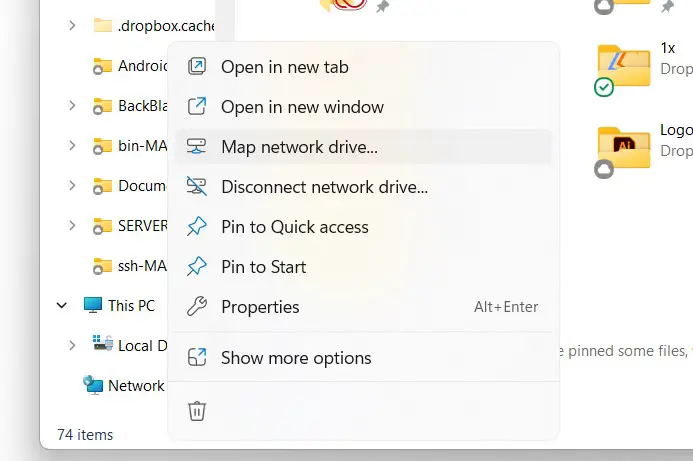
Select the Map network drive… menu option to display the dialog illustrated in Figure 21-4:
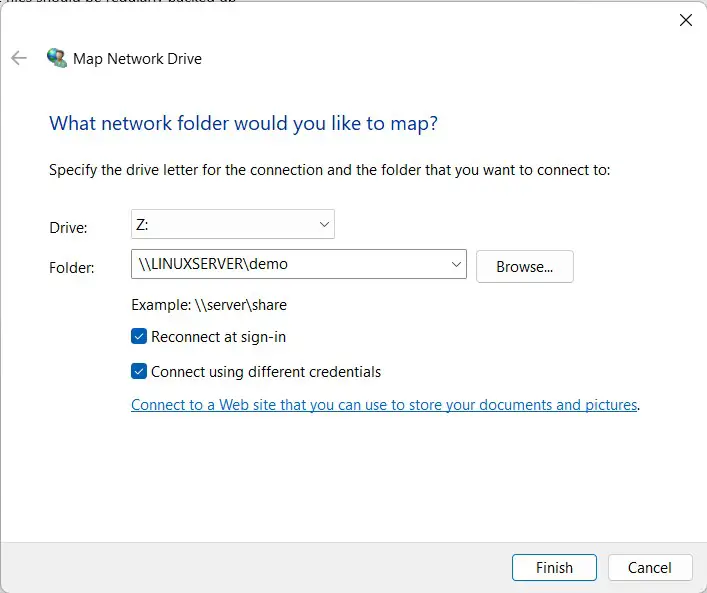
Select a drive letter and enter the path to a samba share. For example, assuming that the server name is LinuxServer and the samba user name is demo, the path to the user’s home folder would be as follows:
\\LINUXSERVER\demoCode language: plaintext (plaintext)Enable the Connect using different credentials checkbox and click finish. When the network credentials dialog appears, enter the Samba user name and the password that was assigned earlier using the smbpasswd command:
 |
You are reading a sample chapter from Ubuntu 22.04 Essentials. Buy the full book now in eBook ($24.99) format. Includes 36 chapters. Learn more. |
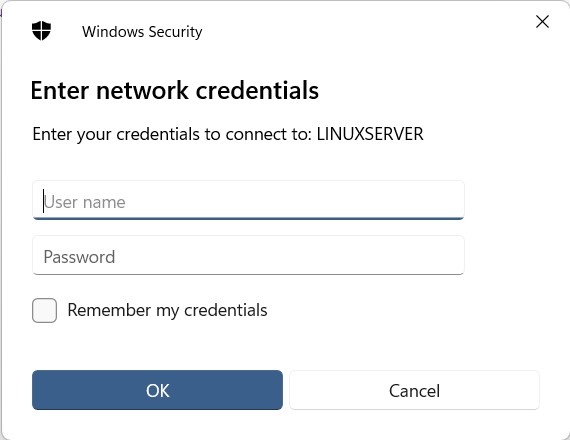
After the connection is established, a new Windows Explorer dialog will appear containing the contents of the shared Ubuntu folder:
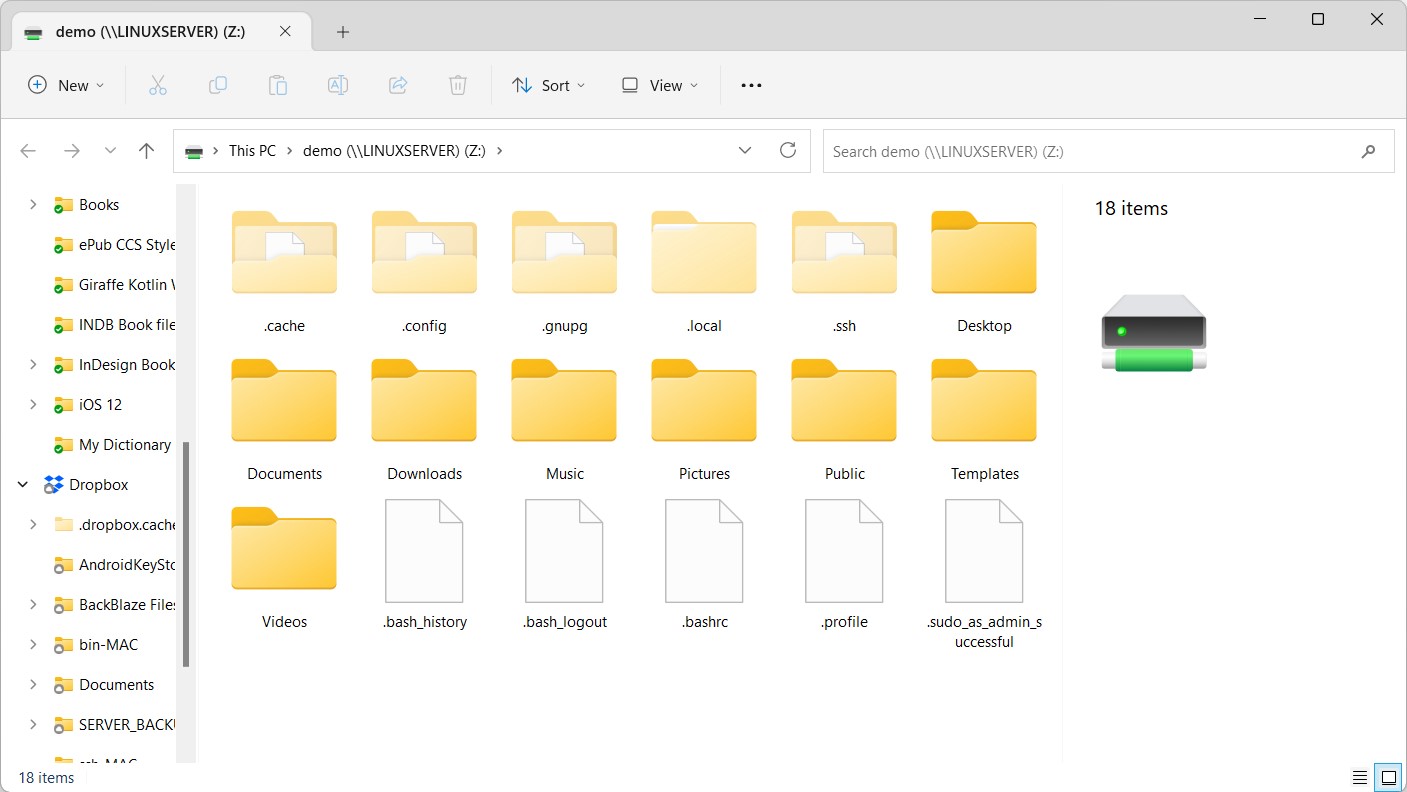
Accessing Windows Shares from Ubuntu
As previously mentioned, Samba is a two-way street, allowing not only Windows systems to access files and printers hosted on an Ubuntu system but also allowing the Ubuntu system to access shared resources on Windows systems. This is achieved using the samba-client package, installed at this chapter’s start. If it is not currently installed, install it from a terminal window as follows:
# dnf install samba-clientCode language: plaintext (plaintext)Shared resources on a Windows system can be accessed from the Ubuntu desktop using the Files application or the command-line prompt using the smbclient and mount tools. The steps in this section assume that the Windows system has enabled appropriate network-sharing settings.
To access any shared resources on a Windows system using the GNOME desktop, launch the Files application and select the Other Locations option. This will display the screen shown in Figure 21-7 below, including an icon for the Windows Network (if one is detected):
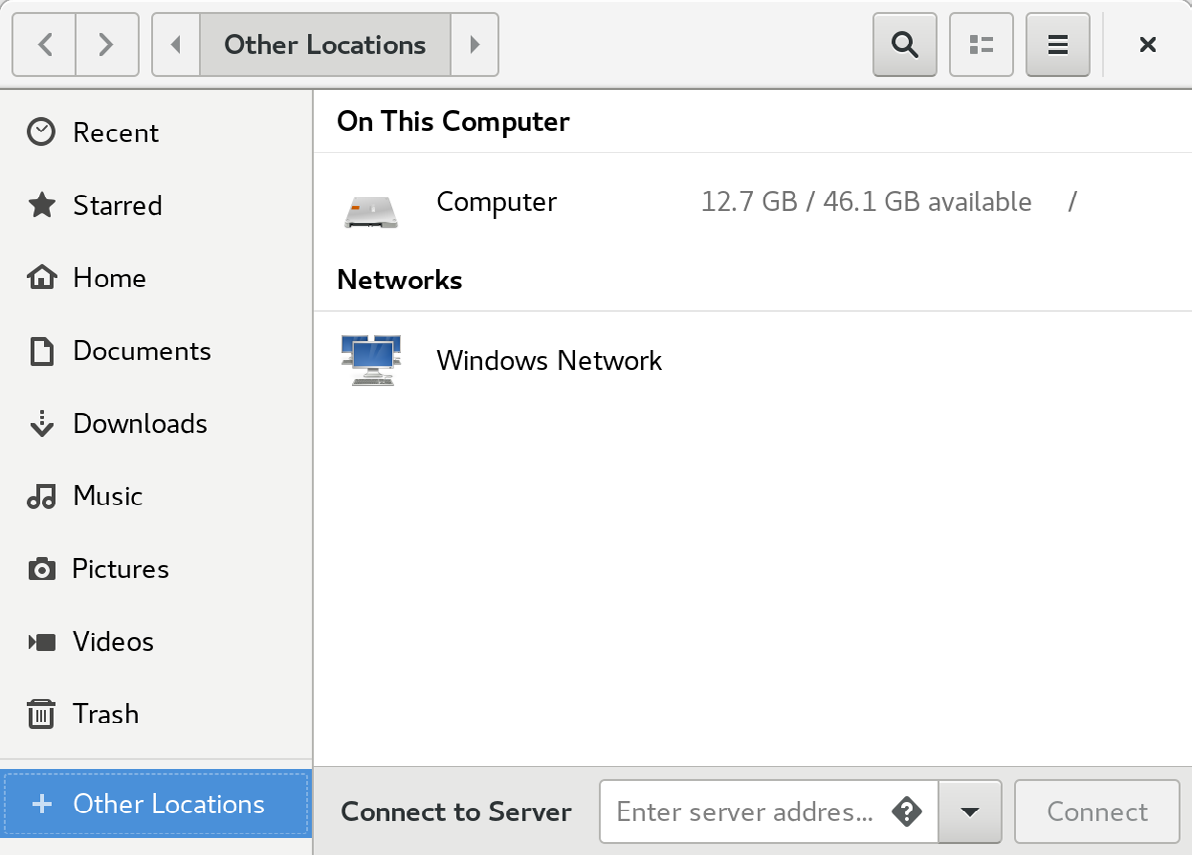
Selecting the Windows Network option will display the Windows systems detected on the network and allow access to any shared resources.
 |
You are reading a sample chapter from Ubuntu 22.04 Essentials. Buy the full book now in eBook ($24.99) format. Includes 36 chapters. Learn more. |
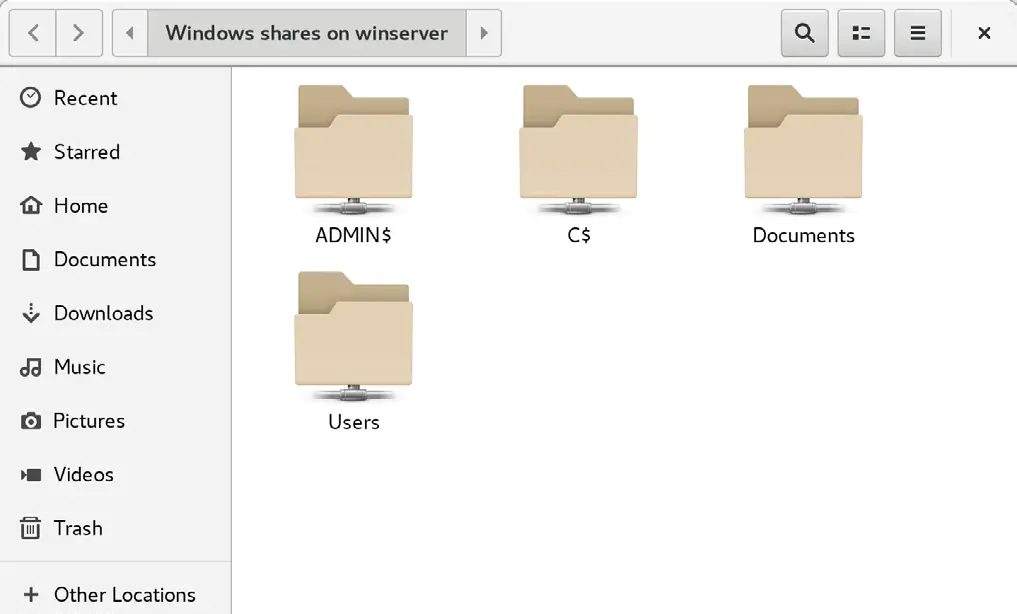
Alternatively, the Connect to Server option may be used to connect to a specific system. Note that the name or IP address of the remote system must be prefixed by smb:// and may be followed by the path to a specific shared resource, for example:
smb://WinServer/DocumentsCode language: plaintext (plaintext)Without a desktop environment, a remote Windows share may be mounted from the command line using the mount command and specifying the cifs filesystem type. The following command, for example, mounts a share named Documents located on a Windows system named WinServer at a local mount point named /winfiles:
# mount -t cifs //WinServer/Documents /winfiles -o user=demoCode language: plaintext (plaintext)Summary
In this chapter, we have looked at how to configure an Ubuntu system to act as both a Samba client and server, allowing the sharing of resources with Windows systems. Topics covered included the installation of Samba client and server packages and configuring Samba as a standalone server. In addition, the basic concepts of SELinux were introduced together with the steps to provide Samba access to a shared resource.

